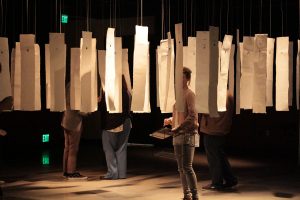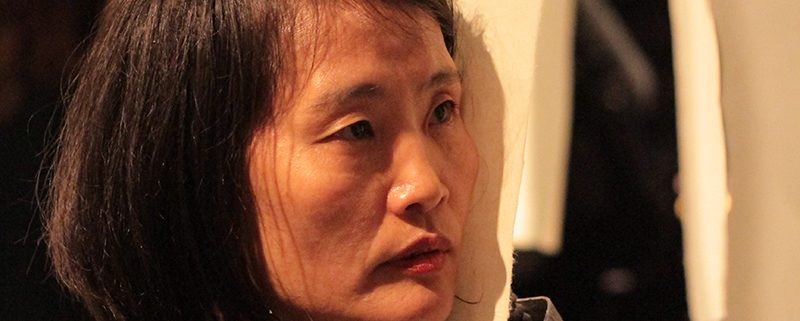Nightfield integrates mechanics with art
Korean artist Juri Hwang’s latest project is an imaginative installation. Hwang, a PhD student studying media arts and practice, used her experience as a multimedia artist to create audiovisual elements that create a strong thematic impression in her latest installation Nightfield.
Due to her professional experiences in Los Angeles, Berlin and Dolsan, Hwang’s art, according to her website, lies “at the intersection of documentary and fiction.”
Her past creations encompass collaborative and solo projects, ranging from video work on theorist Albert Einstein to a case study on an extraordinary boy undergoing life-changing procedures. Her work draws not only on ideas embedded within the mechanics of science, but also on abstract concepts from deep within the human psyche.
The initially unassuming exhibit Nightfield is much more than what meets the eyes and ears. Seventy-two strips of white hanji, a traditional paper derived from mulberry trees once used for doors and now for art, are suspended in the air by wires. These wires emit vibrations that sound similar to wind blowing through a forest.
Each strip has a different sound due to the varying densities of the hanji paper, ranging from the strong winds that weave through trees to the groaning stomach of a ghost.
The papers cycle through the sounds; during some intervals, nothing can be heard, and at others, the volume noticeably increases as the audience listens.
As far as subjectivity goes, Nightfield can be interpreted based on the viewer’s personal experiences with nature, yet the work also touches on an overarching theme.
“There is something that generally everyone shares as a human being — this wind sound that touches me from very early on — there must be some reason [for it],” Hwang said. “For me it is a very personal memory, and it may evoke the same idea in others.”
The title comes from a concept that humans are inside while experiencing the outside in their associations with nature. Similar to her concept with wind, Hwang mentioned that the ocean is another aspect of nature most people relate to, but their feelings about it varies.

Sound and subjectivity · Korean artist Juri Hwang fuses the past, present and the senses in her sound installation Nightfield. The auditory work was inspired by Hwang’s childhood experiences in Korea – Jessica Magana | Daily Trojan
Though this installation appealed immensely to the auditory senses, the experience was ultimately visceral. Viewers were encouraged by Hwang to hold the pieces of fabric up to their ears and to press them against their faces. They then become participants, interacting with the installation and ultimately becoming part of the art itself. Hwang often focuses her artwork on the auditory senses, as opposed to visual or tactile senses.
“Ears are constant, you cannot close them,” she said.
She believes that viewers have a less conscious understanding of how they process sound. Hwang notes that humans become acquainted with sounds in the womb, and she addresses the profound impact it has on human development — audio’s strength is often overshadowed by its omnipresence.
“These sounds of nature bring an involuntary awareness of the outside world,” Hwang said.
The outside world she refers to is the white noise that people are immune to, since it constantly surrounds them.
Nightfield, however, goes beyond prompting one to become aware of the outside — it encourages its audience to become aware of what is within themselves. Though this installation was inspired greatly by Hwang’s own childhood memories in Korea and how she remembers, she also believes that there are essential aspects that human beings can relate to.
“We react to certain things a similar way … Generally, there is something we all share as human beings,” Hwang said.
Her work not only exudes Jungian ideas of the personal and collective unconscious, but also focuses and thrives on the dance between the two.
Though the sounds of wind in her installation may bring nature to the mind of one viewer, fear and isolation could also be interpreted by a different viewer.
On view at the School of Cinematic Arts until March 3, Nightfield is sure to captivate attendees and offer an organic experience, one both shared and personal.

